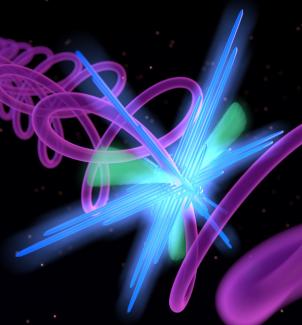For decades after the invention of the red ruby laser in 1960, bright laser-like beams were confined to the infrared, visible, and ultraviolet region of the spectrum. Today there’s an exciting revolution afoot: new coherent x-ray beams are now practical, including the EUV beams gracing the cover of the May 1, 2015, special issue of Science honoring the International Year of Light. The same issue features an article entitled “Beyond Crystallography: Diffractive Imaging Using Coherent X-ray Light Sources” that celebrates the revolutionary advances in both large- and small-scale coherent x-ray sources that are transforming imaging in the 21st century. The article’s authors are JILA Fellow Margaret Murnane, Jianwei Miao (UCLA), Tetsuya Ishikawa (RIKEN, Japan), and Ian K. Robinson (University College London).
While all the new x-ray light sources are remarkable, tabletop high-harmonic generation (HHG) pioneered at JILA by the Kapteyn/Murnane group is quite unique. Harnessing a new ability to manipulate the fastest motions of electrons using visible lasers, the K/M group and its collaborators have demonstrated exquisite control over all aspects of x-ray beams, including what colors are emitted, how long the x-ray bursts last, their polarization, and even the direction that the x-ray beams emerge. What’s more, by using the magic of quantum mechanics, laser beams can tweak x-ray waves with sub-angstrom and sub-attosecond precision to generate x-ray beams that span the entire electromagnetic spectrum from the ultraviolet to the soft x-ray region. These HHG pulses produce bursts ranging from tens of attoseconds to hundreds of femtoseconds.
In parallel with the emergence of the first bright laser-like x-ray beams, a new approach for microscopy called lensless coherent diffractive imaging (CDI), is making it possible to make stunning images of the nanoworld. This new approach is important because, until very recently, x-ray microscopes were severely limited by imperfections in x-ray optics. However, in a lensless microscope, a coherent laser beam illuminates an object and the scattered light is collected on a detector. The image of the object is then recovered via a special set of mathematical rules known as an algorithm. This approach is opening up entire new research frontiers in physics, materials and biology.
As the revolution in coherent x-ray light sources of all sizes continues, x-ray microscopes based on CDI will make it possible to make a real-time movie of the fastest events in the nanoworld. Stay tuned for exciting future developments.—Margaret Murnane and Julie Phillips




